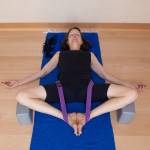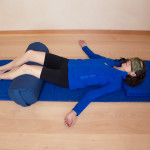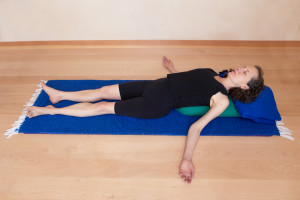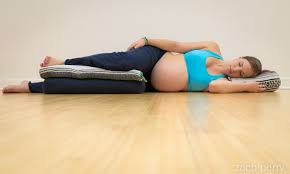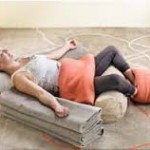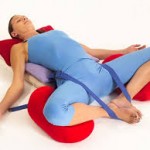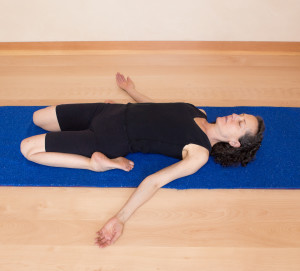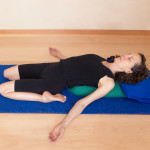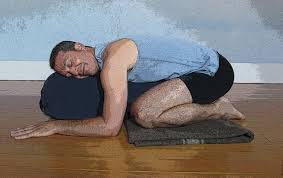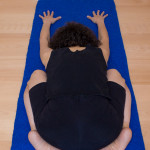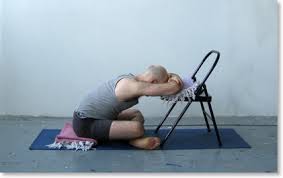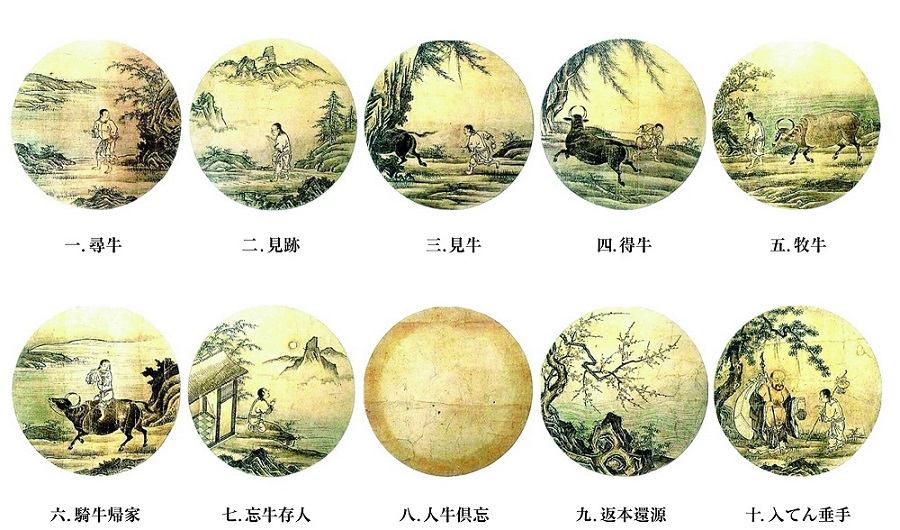Lesson 8: Poses for Quiet Explorations
Restorative yoga poses uses props such as bolsters, blankets, blocks and belts, as well as weights, to allow the body to assume yoga postures that are relaxing and opening simultaneously. Some of the ‘advanced’ restoratives use chairs and benches. B.K.S. Iyengar is the pioneering genius behind this revolutionary approach to asana and most of what will be presented here originates from his insights into working with the infirm and flexibility challenged in his therapeutic classes in Pune. His own practice for the last twenty years has included a deep exploration of supported postures, especially backbends. We will not take it quite so far here, but take notice of the openness and evenness to his organ energy, and the aliveness of his feet and hands. He has a clock for timings as well!
We will introduce a few of the fundamental restorative poses here. In a later session, we will address the notion of sequencing these poses for a class room setting. Remember restorative does not necessarily mean passive. Savasana can be a totally passive pose, but some of the others may require some conscious directing of attention and energy to keep the body aligned and the energy flowing freely. The props take away the need for effort, but are not an invitation to just space out. They are an invitation for a deep somatic meditation.
The basic restorative posture is savasana, the corpse pose, usually done at the end of class. Most students need support under the knees to help the lower back relax and under the neck and skull if the neck muscles are tight. This student also has an eyebag to help the eyes and brain relax. A variation of supported savasana adds a bolster, or two, to lift and open the chest. Care must be taken to adjust the pelvis so that the lower back is not caught in a tilt that will engage the large erector muscles. Notice the weight in the form of a sand bag on the abdomen to help relax the belly and lower spine. The bolster also offer support to the shoulders, which can hang in an unhealthy way if there is tightness. Another option for tight shoulders, even when lying on the floor, is to take two folded blankets and place one under each arm, from mid humerus out to the hands. This will help the shoulders hang down away from the ribs so the backs of the shoulders let go, without the strain created from the weight of the arms. Pregnant women can do a side lying savasana with knee support, to keep pressure off of the vena cava.
Viparita karani, a mild variation of shoulder stand, is a classical restorative pose, that uses a bolster and the support of a wall. The reversal of gravity is greatly beneficial to the heart and other organs as well as the endocrine system including the thyroid. A belt can be used to tie the legs together as well.
Mr. Iyengar has his own perfectly designed yoga prop for this pose.
Supta baddha konasana, the supported bound angle is another favorite pose, as it opens the groins and lower belly to help digestion, elimination and breathing. Although many students do not support the legs, I highly recommend support to the thighs. the primary tightness is in the outer hip muscles, the gluteus medius and piriformis, not the inner thighs. Without support, more often than not, the outer hip muscles will shorten even more. The inner legs will feel a stretch, but they have very little chance of melting. You want the groins to melt, not stretch. This student is also using a belt to hold the feet and help release the sacral area, a nice bonus to the melting groins. You can also place a block under the feet which can relieve tension in the sacral region. In either position, by extending very subtly out through the feet, you can grow your tail energy, further opening the muladhara.
Supta virasana is a bit more challenging because of the intense knee flexion, but it creates a powerful energetic opening in the chest. A bolster and blanket can also be added to support the spine and ribs and head.
Restorative twisting poses come in two basic flavors: supporting the upper body in a slightly forward bending pose, and supporting the legs, in a slightly back bending or front body opening pose. In the first case, the student has a bolster and a blanket to support the torso and head, and a blanket under the top leg to keep strain from the outer hip. The head here is in a more advanced position. It is also possible to have the head turned toward us, which is a bit less intense if the neck has issues in rotation. In the second pose, the student has extra height under the top thigh and a folded blanket under the same side shoulder, as this arm often does not get near the floor without strain.
Finally we will look at supported seated forward bends. Child’s pose is the most popular, and can be done with or without support.
If the knees are too challenged in child’s pose, the legs can be crossed and a chair and blanket provide support for the head. Try not to collapse the shoulders or neck, so be aware of lengthening the spine even as you are relaxing.
Working with straight legs, like in uppavistha konasana, a chair or bolster can be used depending upon your flexibility. Here the bolster is supported by a block.
Use these poses as a way to deeply relax and yet be in a state of somatic samadhi, feeling the ebb and flow of chi/prana/breath as the body lets go of layer after layer of tension. Feel the rejuvenation as you resume your daily activities, or head on into dreamland and your evenings sleep.


